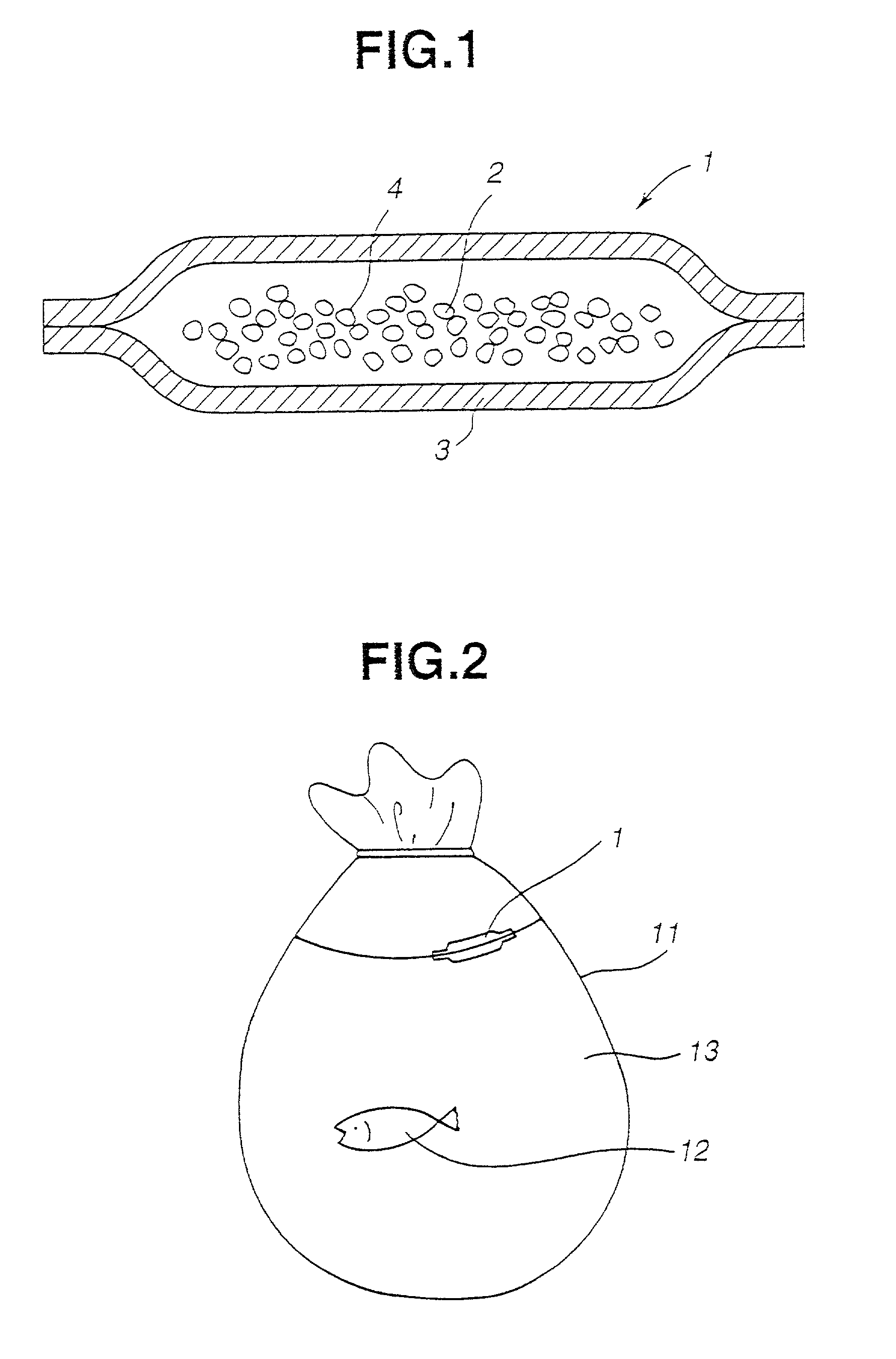Oxygen generating materials, carbon dioxide absorbing materials, and transport system and transport method of live fishery products
a technology of carbon dioxide absorbing materials and oxygen generating materials, which is applied in the direction of transportation and packaging, other chemical processes, packaging goods types, etc., can solve the problems of limited usage, limited usage, and limited use of waterless transportation
- Summary
- Abstract
- Description
- Claims
- Application Information
AI Technical Summary
Benefits of technology
Problems solved by technology
Method used
Image
Examples
example 2
(Example 2)
[0093] Similar procedures were taken as Example 1, except that one sheet of polyethylene non-woven fabric with a thickness of 160 .mu.m and one sheet of laminated film made by dry laminating holeless polyethylene film and polyethylene terephthalate film were used instead of two sheets of polyethylene non-woven fabric with a thickness of 160 .mu.m.
[0094] The cumulative oxygen generation amount from the time of preparation was 1.1 liters after 24 hours, 2.4 liters after 72 hours and 3.5 liters after 120 hours.
example 3
(Example 3)
[0095] Similar procedures were taken as Example 1, except that two sheets of packaging material made by heat fusing three layers, namely polypropylene microporous film with a thickness of 50 .mu.m (Juraguard; U.S.A.; manufactured by Celanese Corp.), polyethylene reinforcing material (Nisseki Warif; manufactured by Nippon Petrochemical Co., Ltd.), and polyethylene film possessing small pores having a 0.3 mm diameter in 7 mm intervals in each direction of left, right, up and down, were used instead of two sheets of polyethylene non-woven fabric with a thickness of 160 .mu.m. However, heat sealing was performed such that the porous sheet layer would be on the inner side of the package.
[0096] The cumulative oxygen generation amount from the time of preparation was 0.7 liters after 24 hours, 2.0 liters after 72 hours and 3.2 liters after 120 hours.
example 4
(Example 4)
[0097] Similar procedures were taken as Example 1, except that one sheet of laminated packaging material made by laminating an EVA film with a thickness of 40 .mu.m and possessing small pores having a 0.2 mm diameter in 1 mm intervals in each direction of left, right, up and down, and a multi-microporous film with a thickness of 150 .mu.m (Cellpore; manufactured by Sekisui Chemical Co., Ltd.) and one sheet of polyethylene non-woven fabric with a thickness of 160 .mu.m were used instead of two sheets of polyethylene non-woven fabric with a thickness of 160 .mu.m shown in FIG. 4. However, heat sealing was performed such that the EVA layer would be on the inner side of the package.
[0098] The cumulative oxygen generation amount from the time of preparation was 1.2 liters after 24 hours, 2.7 liters after 72 hours and 3.5 liters after 120 hours.
PUM
| Property | Measurement | Unit |
|---|---|---|
| RH | aaaaa | aaaaa |
| particle size | aaaaa | aaaaa |
| particle size | aaaaa | aaaaa |
Abstract
Description
Claims
Application Information
 Login to View More
Login to View More - R&D
- Intellectual Property
- Life Sciences
- Materials
- Tech Scout
- Unparalleled Data Quality
- Higher Quality Content
- 60% Fewer Hallucinations
Browse by: Latest US Patents, China's latest patents, Technical Efficacy Thesaurus, Application Domain, Technology Topic, Popular Technical Reports.
© 2025 PatSnap. All rights reserved.Legal|Privacy policy|Modern Slavery Act Transparency Statement|Sitemap|About US| Contact US: help@patsnap.com



